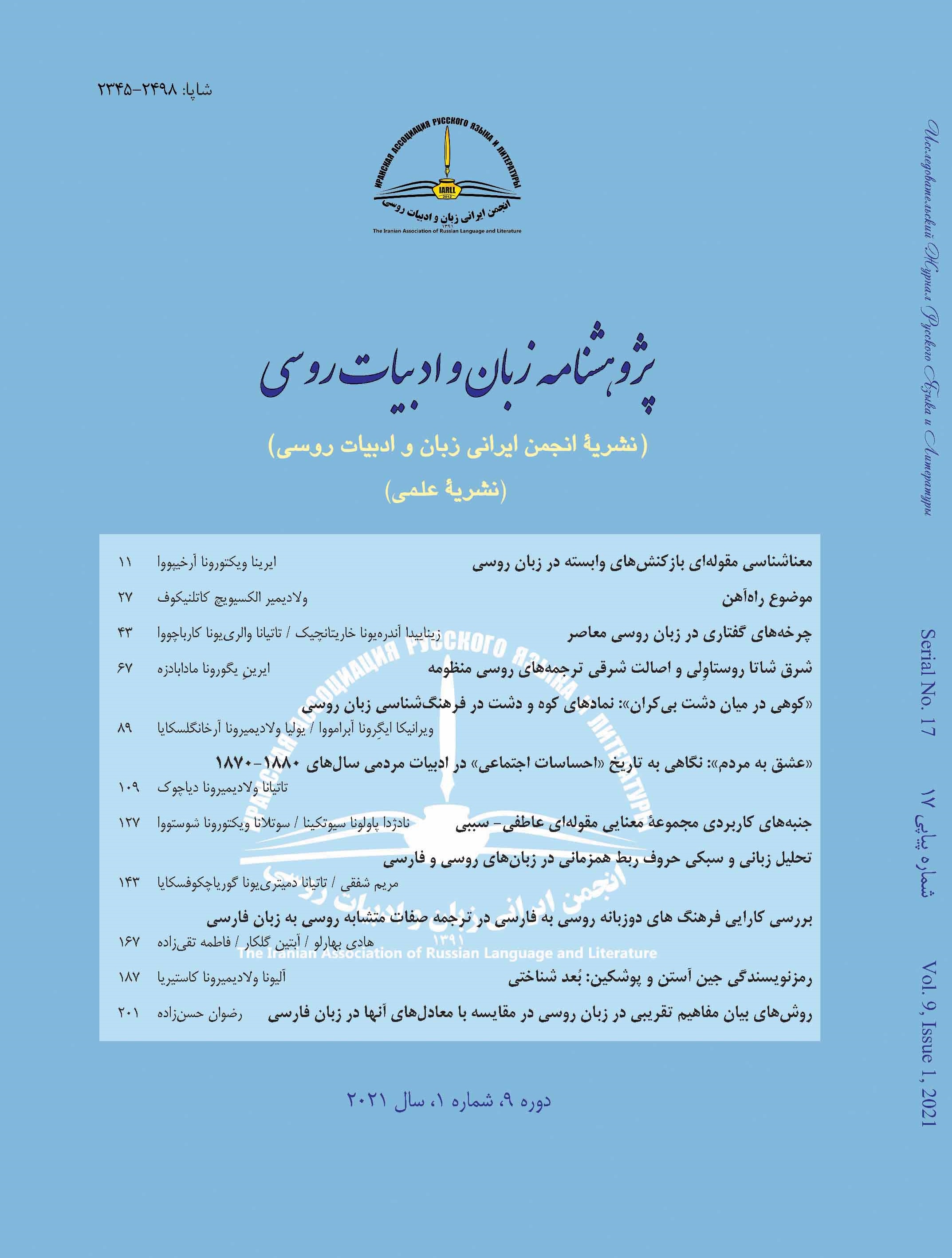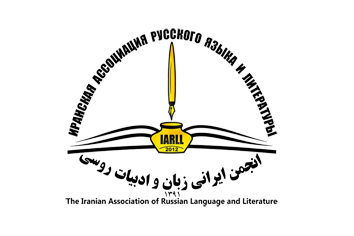Jane Austen’s and Pushkin’s Author Code: Cognitive Aspect
DOI:
https://doi.org/10.52547/iarll.17.187Keywords:
Narrative, Linguo-stylistic Tools, Cognitive Research, Cognitive Poetics, Jane Austen, Pushkin.Abstract
The subject of research in this article is the narrative features of Jane Austen's novels and, at the same time, the essential features of her idiostyle. We consider the system of Austen's distinctive ways of using language as a stylistic code of narration or narrative. We will consider the similarity of realistic writing in the novels of Austen and Pushkin, as well as the narrative features and linguistic stylistic means by which Austen arranges and interprets reality in his novels. Their division into two main groups allows us to structure modern ideas of critics and researchers about the author's style of the writer, as well as to deduce two key features of her novels. The conclusions presented in the article are related to the prospects of "Austen studies", since the analysis of critical discourse has shown that only a cognitive understanding of the creative heritage of Austen will allow us to fully reveal the true potential and intentions of the author's consciousness in the future. In particular, the analysis of the Austen narrative in the context of cognitive poetics and theory of mind. For the first time, Austen’s research highlights the phenomenon of embedded consciousness and intersubjectivity in the interpretation of her novels, and states pseudo-realism and pseudo-moral teaching as essential characteristics of her creative writing. The presented analysis is concerned with modern literary and linguo-cognitive works about Austen’s legacy abroad. An assumption is made about possible directions of research in the field of cognitive poetics in Russia.
References
- Бахтин М. М. (1979) Эстетика словесного творчества. – М.: «Искусство», 423 с.
- Гениева Е.Ю. (2014). Вступительная статья. Джейн Остен. Малое собрание сочинений. – СПб.: «Азбука», 860 с.
- Демурова Н.М. Михальская Н.П. Комментарии к роману
«Мэнсфилд-парк». URL: https://www.apropospage.ru/lib/osten/m_park/m_prim.html (дата обращения: 02.07.2019).
- Жутовская Н.М., Александрова Е.Е. Черты нравоописательной литературы в романе Джейн Остин «Разум и чувства». URL: https://cyberleninka.ru/article/n/cherty-nravoopisatelnoy-literatury-v-romane-dzheyn-ostin-razum-i-chuvstva (дата обращения: 31.05.2019).
- Зинченко Н.С. Дискурсивная ирония в диалогах персонажей (на материале романа Дж. Остен «Гордость и предубеждение»). URL: http://www.apriori-journal.ru/journal-gumanitarnie-nauki/id/1035 (дата обращения: 07.05.2019)
- Палий А.А. (2011). Несобственно-прямая речь в романах Джейн Остин как одно из проявлений её стилистического новаторства // Омский научный вестник, № 5. С. 136-138.
- Палий A.A. О значении творчества Джейн Остин URL: https://cyberleninka.ru/ article/n/o-znachenii-tvorchestva-dzheyn-ostin (дата обращения: 02.06.2019).
- Повзун Е.В. (1813).Черты романтизма и реализма в романе Джейн Остен "Гордость и предубеждение". URL: http://elib.bsu.by/handle/123456789/39914 (дата обращения: 18.04.2019).
- Шамина В. Б., Прохорова Т. Г. Дж. Остин и А. С. Пушкин: изображение усадебного быта // Учен. зап. Казан. ун-та. Сер. Гуманит. науки. URL: https://cyberleninka.ru/article/n/dzh-ostin-i-a-s-pushkin-izobrazhenie-usadebnogo-byta (дата обращения: 02.07.2020).
- Bonaparte F. (2005). Conjecturing possibilities: reading and misreading texts in Jane Austen’s ‘Pride and prejudice’. The Johns Hopkins University Press Studies in the Novel, vol. 37, no. 2, pp. 141–161.
- Butte G. (2004). I Know that You Know that I Know: Narrating Subjects from "Moll Flanders to Marnie". Columbus: Ohio State University Press, 270 p.
- Copeland E. McMaster J. (2010). The Cambridge Companion to Jane Austen. Cambridge: Cambridge University Press, 302 p.
- Gay P. (2002). Jane Austen and the Theatre. Cambridge: Cambridge University Press, 201 р.
- Lau B. (2017). Jane Austen and Sciences of the Mind. London: Imprint Routledge, 248 p.
- Morini M. (2009). Jane Austen's narrative techniques. A stylistic and pragmatic analysis. Cornwall: MPG Books Ltd, 172 p.
- Moses C. (2003). Jane Austen and Elizabeth Bennet: The Limits of Irony // Persuasions (The Jane Austen Journal). No. 25, Pp. 155-164.
- Nelles W. (2014). Jane’s Brains: Austen and Cognitive Theory // Interdisciplinary Literary Studies. University Park: Penn State University Press, Pp. 6-29.
- Phillips N. Distraction as Liveliness of Mind: A Cognitive Approach to Characterization in Jane Austen. URL: https://pdfs.semanticscholar.org/8aca/ bba786ae8f09fba7789088d7b9f3c800eda6.pdf (дата обращения: 08.08.2019)
- Richardson A. (2010). The Neural Sublime: Cognitive Theories and Romantic Texts. Baltimore: Johns Hopkins University Press, 179 p.
- Waldron M. (2003). Jane Austen and the fiction of her time. Cambridge: Cambridge University Press, 204 p.
- Woudenberg F. The Business of Marriage: Metaphors in Jane Austen’s Pride and Prejudice. URL: dspace.library.uu.nl (дата обращения: 10.12.2019)
- Zunshine L. Why Jane Austen was different, and why we may need cognitive URL: http://www.sscnet.ucla.edu/polisci/faculty/chwe/austen/zunshine2007.pdf (дата обращения: 05.08.2019)
- Zunshine L. (2006). Why we read fiction: theory of mind and the novel. Columbus: The Ohio State University, 198 p.
Bibliography
- Bahtin M. M. (1979) Jestetika slovesnogo tvorchestva. – M.: «Iskusstvo», 423 s.
- Genieva E.Ju. (2014). Vstupitel'naja stat'ja. Dzhejn Osten. Maloe sobranie sochinenij. – SPb.: «Azbuka», 860 s.
- Demurova N.M. Mihal'skaja N.P. Kommentarii k romanu «Mjensfild-park». URL: https://www.apropospage.ru/lib/osten/m_park/m_prim.html (data obrashhenija: 02.07.2019).
- Zhutovskaja N.M., Aleksandrova E.E. Cherty nravoopisatel'noj literatury v romane Dzhejn Ostin «Razum i chuvstva». URL: https://cyberleninka.ru/article/n/cherty-nravoopisatelnoy-literatury-v-romane-dzheyn-ostin-razum-i-chuvstva (data obrashhenija: 31.05.2019).
- Zinchenko N.S. Diskursivnaja ironija v dialogah personazhej (na materiale romana Dzh. Osten «Gordost' i predubezhdenie»). URL: http://www.apriori-journal.ru/journal-gumanitarnie-nauki/id/1035 (data obrashhenija: 07.05.2019)
- Palij A.A. (2011). Nesobstvenno-prjamaja rech' v romanah Dzhejn Ostin kak odno iz projavlenij ejo stilisticheskogo novatorstva // Omskij nauchnyj vestnik, № 5. S. 136-138.
- Palij A.A. O znachenii tvorchestva Dzhejn Ostin. URL: https://cyberleninka.ru/ article/n/o-znachenii-tvorchestva-dzheyn-ostin (data obrashhenija: 02.06.2019).
- Povzun E.V. (1813). Cherty romantizma i realizma v romane Dzhejn Osten "Gordost' i predubezhdenie" URL: http://elib.bsu.by/handle/123456789/39914 (data obrashhenija: 18.04.2019).
- Shamina V. B., Prohorova T. G. Dzh. Ostin i A. S. Pushkin: izobrazhenie usadebnogo byta // Uchen. zap. Kazan. un-ta. Ser. Gumanit. nauki. URL: https://cyberleninka.ru/article/n/dzh-ostin-i-a-s-pushkin-izobrazhenie-usadebnogo-byta (data obrashhenija: 02.07.2020).
- Bonaparte F. (2005). Conjecturing possibilities: reading and misreading texts in Jane Austen’s ‘Pride and prejudice’. The Johns Hopkins University Press Studies in the Novel, vol. 37, no. 2, pp. 141–161.
- Butte G. (2004). I Know that You Know that I Know: Narrating Subjects from "Moll Flanders to Marnie". Columbus: Ohio State University Press, 270 p.
- Copeland E. McMaster J. (2010). The Cambridge Companion to Jane Austen. Cambridge: Cambridge University Press, 302 p.
- Gay P. (2002). Jane Austen and the Theatre. Cambridge: Cambridge University Press, 201 r.
- Lau B. (2017). Jane Austen and Sciences of the Mind. London: Imprint Routledge, 248 p.
- Morini M. (2009). Jane Austen's narrative techniques. A stylistic and pragmatic analysis. Cornwall: MPG Books Ltd, 172 p.
- Moses C. (2003). Jane Austen and Elizabeth Bennet: The Limits of Irony // Persuasions (The Jane Austen Journal). No. 25, Pp. 155-164.
- Nelles W. (2014). Jane’s Brains: Austen and Cognitive Theory // Interdisciplinary Literary Studies. University Park: Penn State University Press, Pp. 6-29.
- Phillips N. Distraction as Liveliness of Mind: A Cognitive Approach to Characterization in Jane Austen. URL: https://pdfs.semanticscholar.org/8aca/ bba786ae8f09fba7789088d7b9f3c800eda6.pdf (data obrashhenija: 08.08.2019)
- Richardson A. (2010). The Neural Sublime: Cognitive Theories and Romantic Texts. Baltimore: Johns Hopkins University Press, 179 p.
- Waldron M. (2003). Jane Austen and the fiction of her time. Cambridge: Cambridge University Press, 204 p.
- Woudenberg F. The Business of Marriage: Metaphors in Jane Austen’s Pride and Prejudice. URL: dspace.library.uu.nl (data obrashhenija: 10.12.2019)
- Zunshine L. Why Jane Austen was different, and why we may need cognitive science to see it. URL: http://www.sscnet.ucla.edu/polisci/faculty/chwe/austen/ zunshine2007.pdf (data obrashhenija: 05.08.2019)
- Zunshine L. (2006). Why we read fiction: theory of mind and the novel. Columbus: The Ohio State University, 198 p.
Downloads
Published
How to Cite
Issue
Section
License
Copyright (c) 2021 Issledovatel'skiy Zhurnal Russkogo Yazyka i Literatury

This work is licensed under a Creative Commons Attribution 4.0 International License.
![]()
"Creative Commons Attribution 4.0 International (CC-BY 4.0)"


